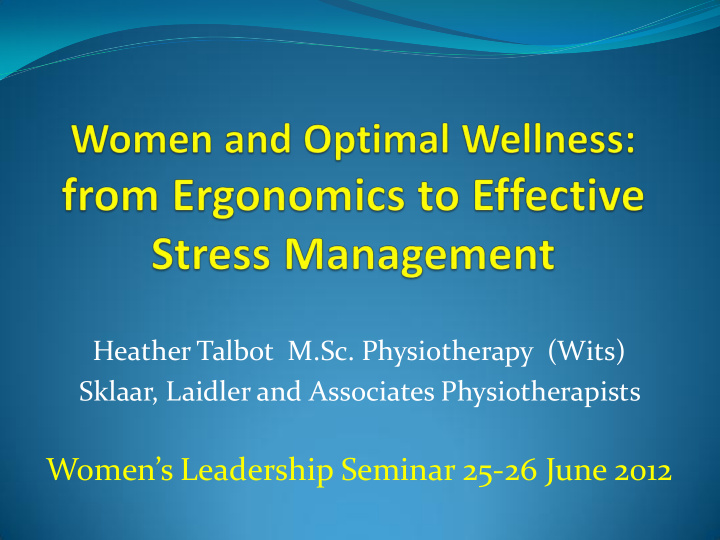



Heather Talbot M.Sc. Physiotherapy (Wits) Sklaar, Laidler and Associates Physiotherapists Women’s Leadership Seminar 25 -26 June 2012
Science of designing workplaces, equipment and tasks within the capabilities of the human body and mind. Ergo = work/effort Nomos = natural law/surroundings
The goals of ergonomics are to optimise: human well-being overall system performance.
Ergo System human productivity environment machine
What does it all mean? 1. Human • emotional and physical well-being • poor working habits 2. Machine • appropriate equipment • maintenance and safety of equipment 3. Environment • physical e.g. workstation design, temperature, lighting and noise • emotional e.g. relationships and support systems amongst colleagues
The Human Body
Cycle of Injury Injury Pain Postural Protective strain posture Weakness Stiffness
Repetitive Strain Injuries Repetitive movements Sustained postures Poor postural habits Fatigue Decreased level of fitness
Ideal Computer Station Design • Adjustable tilted screen. • Screen and work surface free of glare and reflection. • Good lighting (avoid a glare or reflection on the screen). • Adjustable chair with casters and suitable armrests. • Space under the desk clear for legs. • Keyboard and mouse in close proximity.
Correct Sitting Posture Sit far back into the chair so that back is well supported. Head in a balanced position (avoid poking head forwards). Top of screen at eye level. Shoulders relaxed and upper arms vertical. Forearms and wrists horizontal and supported. Knees bent to +/- 90 degrees. Hips positioned slightly higher than knees. Feet flat on the floor (foot rest for shorter people ).
Common Workstation Faults Armrests are not suitable for the desk
Perching on the edge of the chair.
Mouse pad is too far back on the desk. Keyboard lead is too short.
Holding the telephone between the neck and shoulder.
Sitting at an angle to the screen. Holding the telephone between the neck and shoulder.
Stressors A significant life change or event can be a stressor. Either a major positive or negative event can be stressful. Stressors may precipitate, exacerbate or perpetuate neck and back pain.
The Mind-Body Connection Brain has developed over millions of years. Most primitive part of the brain is the brainstem. Limbic system was the first true emotional component of the brain to develop. Cortex allows for thought, reflection and analysis to take place. Cortex facilitated the development of emotional “fine - tuning “.
The Stress Response Signals are transmitted via the nervous system from the brain to the body. Sympathetic nervous system is activated by the limbic system. Hormones such as adrenalin, nor-adrenalin, cortisol and prolactin are released. The body goes into “red alert” i.e. the “fight or flight response” . Parasympathetic nervous system is activated when the threat has passed. The body goes into “green alert” i.e. the “rest and digest response” .
Symptoms of Stress Physical Emotional and Behavioural Loss of appetite Irritability Constipation or diarrhoea Irrationality Tiredness Anxiety Insomnia Emotionally variable Poor concentration and memory Negativity Skin rashes Feeling of doom Colds and flu Intolerance to noise Reduced sex drive Over eating Chest pain
Chronic Stress Chronic stress is a common problem of modern living. Sympathetic nervous system remains constantly aroused. Immunity system is suppressed. Internal organs are prone to disease. Recurrent musculoskeletal symptoms.
Learning How to Relax Breathing exercises. Visualisation and meditation. Exercise. Creative hobby or outlet. Massage and aromatherapy. Take regular holidays.
Ten Habits of Effective Life Managers Manage their time Know how to relax. efficiently. Eat right and exercise Have and make use of a often. strong social support Get enough sleep. system. Don’t worry about Live according to their unimportant things. values. Don’t get angry often. Have a good sense of Are organised. humour.
References Discovery Health Back Care Programme 2007 1. www.apple.com/about/ergonomics 2. www.kwantlen.ca/shared/assets/ergonomic 3.
Questions ? ? ? ? ? ? ? ? ? ? ? ? ? ? ? ? ? ? ? ? ? ? ? ? ? ? ? ? ? ? ? ? ? ? ? ? ? ? ? ?
THANK YOU

Recommend
More recommend